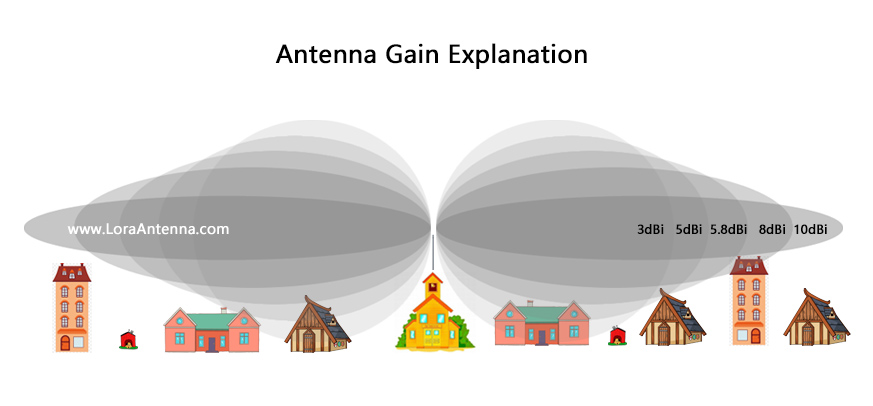Categories
- Antenna Knowledges (15)

Low gain antennas (3 dBi) have a broad radiation pattern and are best for rugged terrain or a dense urban environment. Your signal is less likely to be blocked by obstacles such as buildings and hills tight to your location.
Medium gain antennas (5dBi and 5.8 dBi) have a more rounded and broader pattern. These antennas work well around obstructions and are great for suburban areas. In addition, they would allow you to connect with hotspots that are both vertically and horizontally near you.
High gain antennas (8dbi and 10dBi) radiate in a narrow pattern for a longer distance and are great for flat terrain with few obstacles. However, if your antenna location is high, your signal may overshoot anything below you. If your antenna is low down, obstructions may block your signal.
Antenna gain indicates how strong a signal an antenna can send or receive in a specified direction. Gain is calculated by comparing the measured power transmitted or received by the antenna in a specific direction to the power transmitted or received by a hypothetical ideal antenna in the same situation. If the comparison is to an ideal (text-book pattern, lossless) antenna radiating or receiving energy equally in all directions, the gain is measured in dBi (decibels-isotropic). If the comparison is to an ideal lossless half-wave dipole antenna, defined as having 2.15 dB gain, the gain is measured in dBd (decibels-dipole). Note that the decibel is a logarithmic unit, meaning a 6dB is almost four times the reference power; 7 dB is five times the reference power, etc.
Direction of the power propagation is a key characteristic of antennas. Gain is often represented in a two-dimensional plot of the radiation pattern where the radius of the plot is on a decibel scale that may be normalized to maximum value for the particular antenna, or to an isotropic radiator. The direction that has the most power is considered the main lobe, exactly opposite the main lobe is the back lobe, and any other unwanted or unintended radiation features are called sidelobes. If no direction is specified, gain refers to peak value in the direction of the antenna’s main lobe.
Often manufacturers of antennas (be they wifi antennas, gps antennas, or tv antennas) specify the antenna gain. For instance, manufacturers of wifi antennas may market the wifi antenna as a “high gain antenna”, which is more expensive than a similar low gain antenna. The question is: do we want high gain?
The answer is: it depends. If you know exactly where your desired signal is coming from, you would like to have maximum gain (towards the desired) direction. However, if you don’t know where the desired signal will be coming from, it is better to have a low gain antenna. A couple examples will make this clear.
{ Example #1 } – TV Antennas. If you mount a TV antenna on your roof, and know the tv broadcast antennas are to the south (for example, on some hill south of the city), then it is preferred to have a high gain antenna. Antennas with gain of at least 12-15 dB are preferred.
{ Example #2 } – GPS (Global Positioning System). GPS antennas for mobile devices are receive only. The job of the gps antenna is to triangulate your position by measuring the received signal from multiple gps satellites, which are all in different directions relative to the receive antenna. For this case, a very highly directional antenna would not be preferred.
{ Example #3 } – Mobile Cellular Antennas. The cellular antenna on your smartphone communicates with a single cellular network tower. However, the cellular antenna can be held in any orientation, and can be in any position relative to the network tower. Hence, for your mobile device, it is preferred to have a low gain antenna.
If you look at the specification sheet for an antenna, you will typically see units for antenna gain listed in dB, dBi or dBd. I define these terms below:
dB – decibels, as we have been discussing. 10 dB means 10 times the energy relative to an isotropic antenna in the peak direction of radiation.
dBi – “decibels relative to an isotropic antenna”. This is the same as dB as we have been using it. 3 dBi means twice (2x) the power relative to an isotropic antenna in the peak direction.
dBd – “decibels relative to a dipole antenna”. Note that a half-wavelength dipole antenna has a gain of 2.15 dBi. Hence, 7.85 dBd means the peak gain is 7.85 dB higher than a dipole antenna; this is 10 dB higher than an isotropic antenna.